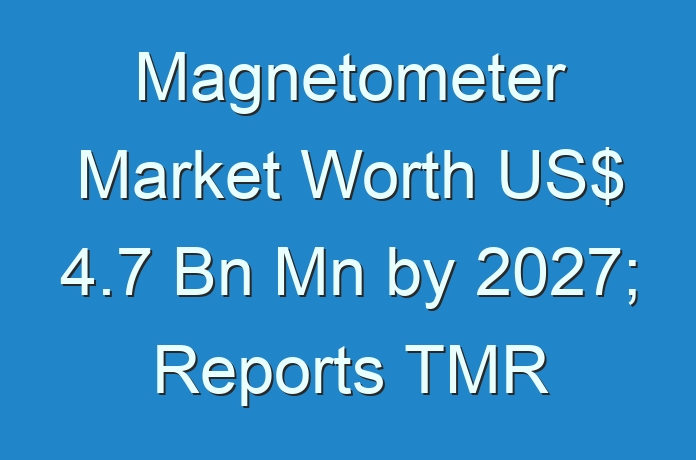
Magnetometer Landscape Transforming with Advancements in Quantum Technology
Long hailed for its widespread use in scouring the Earth’s magnetic field, the adoption of magnetometers has effectively resonated in various industrial applications that involve geophysical surveys and detecting magnetic anomalies. With the ever-expanding range of industrial applications of magnetometers, end users are voicing demand for advancements in their features, such as improved sensitivity, accuracy, and precision.
With the advent of emerging technology, manufacturers in the magnetometer market are focusing on enhancing the quantum properties of atomic sensors to improve the sensitivity and speed of magnetometers, and ultimately improve their efficiency in industrial applications. Ongoing research and development in quantum technologies is expected to contribute toward improving the sensitivity and precision of magnetometry measurements, enabling market players to stand out in the competition with high-performance magnetometers.
Want to know the obstructions to your company’s growth in future? Request a brochure @ https://www.transparencymarketresearch.com/sample/sample.php?flag=S&rep_id=23462
The global magnetometer market report generated by our top analysts at Transparency Market Research scrutinizes the prevailing trends, threats, opportunities, and the key determinants that are fueling the growth of this market during the forecast period.
Magnetometers – How This Market Will Continue to Gather Impetus
Over the years, the magnetometer market has gained momentum, reaching a valuation of ~US$ 2.9 billion in 2018. The landscape is growing fast, owing to the rapidly changing and dynamic environment that has promulgated their use for the detection of mineral deposits, coal exploration, and identifying precious archaeological artefacts, along with their inclusion in consumer electronics and the smartphone industry. This market is expected to touch the ~US$ 3 billion mark by 2019.
The demand for magnetometers is likely remain comparatively higher in developed regions such as North America and Europe, holding a formidable revenue share of the magnetometer market, and continuing their dominance especially in the area of consumer electronics. Though the market is likely to stabilize in the United States and Canada, the market for magnetometers in the European Union (EU) is growing at a fast rate. European countries, including Germany, the United Kingdom, and France are expected to account for one-third revenue share of the global magnetometer market, mainly attributing to the presence of key market players, their penetrative reach across the region, and the heavy funding and investments done in the semiconductor and medical industries in the EU.
Rising Demand for 3-Axis Magnetometers in Aerospace & Defense: An Emerging Trend
Magnetometers are one of the most integral components used in the aviation industry and spacecraft telemetry for developing spacecraft magnetic cleanliness designs. The use of magnetometers in aviation is not restricted to Global Positioning System (GPS) monitoring and tracking, but also involves their application in Unmanned Aerial Vehicles (UAVs) for aerial mapping and investigation. These are some of the key trends that are boosting the sales of magnetometers in the aerospace industry.
The aerospace & defense industry generated over one-third of the total revenue of the global market for magnetometers in 2018, and this demand will only get amplified in the coming years. Ongoing advancements in technologies are enabling manufacturers to improve the performance characteristics of magnetometers to suit the specific requirements vis-à-vis their applications in the aviation and defense industries.
End users in the aerospace & defense industries are showing preference towards the adoption of three-axis magnetometers with unique variable permeability properties, along with excellent noise performance, high sensitivity, and good linearity. Leading stakeholders are likely to increase their focus on capturing the opportunities pertaining to the integration of magnetometers with UAV technology.
Looking for exclusive market insights from business experts? Request a Custom Report
In addition, OEMs and magnetometer suppliers stand to hugely profit due to substantial investments in arenas such as crop monitoring, infrastructure inspection, and accident analysis. Thereby, the increasing use of drones in land mining, farming, and construction lead to faster results and clearer decision making, which will spearhead the sales of magnetometers in these industries over the forecast period.
However, although magnetometers are incorporated into in various devices and equipment, engineers continue to face challenges due to complexities in designing the features of magnetometers, such as noise fluctuations, linearity, and sensitivity. Minor deviations in GPS that use magnetometers for forecasting natural disasters can give out error-prone and misleading information. Further, temperature differences, and the presence of hard iron objects, such as a speaker or magnetized piece of iron, lead to biases and distortions in sensor readings. Such challenges may continue to negatively impact the developments in the magnetometer market.
You May Also Like PRNewswire on Spectrum Analyzer Market





